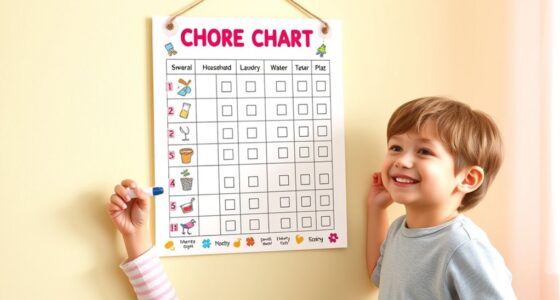Positive discipline focuses on teaching and guiding your child through respectful communication, helping them understand acceptable behaviors without harsh punishments. Unlike punishment, which relies on yelling or threats and can damage trust, positive discipline uses praise, rewards, and setting clear boundaries to encourage internal motivation. This approach fosters self-control and builds a stronger relationship. If you want practical tips on how to implement these gentle strategies effectively, there’s more to explore here.
Key Takeaways
- Positive discipline emphasizes teaching and understanding, whereas punishment relies on harsh measures like yelling or threats.
- Positive methods foster respectful communication and internal motivation, unlike punishment which may cause fear or resentment.
- Clear expectations and consistent routines support positive discipline, while punishment often focuses on immediate compliance.
- Reinforcing good behavior with praise or rewards cultivates internalized habits, unlike punishment that may lead to avoidance.
- Research shows positive discipline builds better parent-child relationships and long-term behavioral improvements compared to punitive approaches.

When it comes to guiding children’s behavior, understanding the difference between positive discipline and punishment can make a significant impact. Positive discipline emphasizes teaching and guiding rather than simply punishing mistakes. With gentle methods, you focus on fostering your child’s understanding of acceptable behavior through respectful communication and constructive strategies. These techniques help children learn self-control and accountability without fear or resentment. Instead of relying on harsh punishments, you can use behavioral rewards—praising good behavior and offering small incentives—to encourage positive actions. This approach promotes a sense of achievement and motivation, making it easier for your child to internalize good habits over time.
Gentle methods involve calmly addressing misbehavior without yelling or threats. When your child acts out, instead of giving a timeout as a punishment, you might choose to discuss what happened and why it’s inappropriate. This not only helps children understand the consequences of their actions but also strengthens your relationship by showing respect. Behavioral rewards play an essential role here because they reinforce the behaviors you want to see. For example, if your child shares toys or tidies up without being asked, praising them or giving a small reward encourages them to repeat those actions. These rewards aren’t just material; they can be verbal affirmations like “I’m proud of you” or extra quality time together, which reinforce positive behavior without the need for punishment.
Positive discipline also involves setting clear expectations and consistent routines. When children know what’s expected of them and understand the boundaries, they feel more secure and are less likely to test limits. When misbehavior occurs, instead of reacting with anger or punishment, you can redirect their attention or offer choices to empower them. For example, if your child refuses to put away toys, you might say, “Would you like to tidy up now or in five minutes?” This approach respects their autonomy and promotes problem-solving skills. Additionally, understanding behavioral rewards can help you effectively encourage desired behaviors while maintaining a positive relationship.
Frequently Asked Questions
How Can I Start Implementing Positive Discipline Immediately?
To start implementing positive discipline immediately, focus on practical tips like setting clear expectations and staying calm during conflicts. Begin with immediate steps such as giving your child simple choices and using positive reinforcement for good behavior. Consistency is key, so practice patience and reinforce positive actions consistently. These steps help create a supportive environment where your child learns self-discipline without harsh punishment.
Are There Cultural Differences in Discipline Approaches?
Imagine you’re in a different country where cultural norms favor strict discipline, and you notice disciplinary variations compared to your home. Cultural differences influence how parents approach discipline, shaping behaviors based on local values and traditions. These variations reflect diverse beliefs about authority and respect. Recognizing such differences helps you adapt your parenting style thoughtfully, respecting cultural norms while fostering positive discipline practices that work well across different cultural contexts.
How Do I Handle Repeated Misbehavior Calmly?
When dealing with repeated misbehavior, you should stay calm by practicing emotional regulation, so your reactions don’t escalate the situation. Use consistency strategies like clear rules and predictable consequences, helping your child understand expectations. Take deep breaths or step away briefly if needed. Consistency and calmness show your child that misbehavior isn’t tolerated, but it’s handled with patience. Over time, this approach fosters better behavior and trust.
What Are Common Misconceptions About Positive Discipline?
When you’re exploring positive discipline, you might encounter discipline myths that mislead you. Myth busting reveals that many believe positive discipline is too lenient or doesn’t teach responsibility, but it actually promotes respect and self-control. Common misconceptions suggest it’s permissive or ineffective, yet evidence shows it fosters better behavior long-term. Understanding these discipline myths helps you implement effective, compassionate strategies, turning discipline into a growth opportunity rather than just punishment.
Can Positive Discipline Work With Teenagers?
You might wonder if gentle parenting strategies can truly influence teenagers, especially as they seek more independence. The truth is, positive discipline can be highly effective with adolescents when you respect their growing need for autonomy. By fostering open communication and understanding, you help them develop responsible decision-making skills, making your parenting approach stronger and more aligned with their developmental stage, ultimately guiding them towards positive behaviors.
Conclusion
Think of discipline as tending a garden. Positive discipline waters and nurtures your child’s growth, helping them blossom into kind, responsible individuals. Punishment, like harsh pruning, may temporarily remove unwanted branches but risks damaging the plant’s future. By choosing patience and understanding, you become a gardener who fosters lasting strength and resilience. Remember, your consistent care shapes a beautiful, thriving future—one where love and guidance are the true roots of growth.










